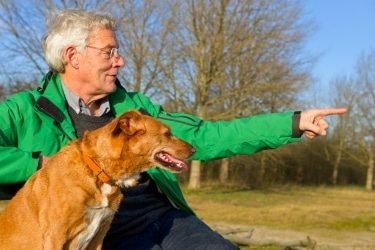The dog is truly man’s best friend.
But how did it happen?
In 2015, Swedish geneticist Pontus Skoglund published a study in the journal Current Biology about the discovery and findings of a 35,000-year-old Siberian wolf bone. He concluded that canine domestication occurred 27,000 to 40,000 years ago. Wolves followed our ancestor hunter-gatherers around and fed on their scraps, each becoming more and more comfortable with the sight and smell of each other.
There is also a theory that this tightening human-wolf bond developed to the point where wolves attacked another tribe that attacked our ancestors. The wolves were simply defending their source of food, but our ancestors interpreted it as something spiritual with the potential for protection and the relationship deepened into a dependency unprecedented between humans and animals.
Dr. Pat Shipman, a professor of anthropology at Penn State University, believes that the domestication of the dog gave humans the edge over Neanderthals. “As the first species to be domesticated, dogs have a very ancient and very profound link to humans that affected both of us,” she said.

Wolf pups are adorable creatures and our ancestors adopted them, but domestication is a tricky affair. An adult wolf is a fierce predator and that cute first-generation pup would eventually mature into an unpredictable and potentially lethal animal. When protecting itself, a wolf can bite down with over 1,200 pounds PSI (pressure per square inch). In comparison, a Siberian Tiger has a bite force of 950 pounds PSI.
Regardless, the interaction between ancient man and the wolf continued to evolve and resulted in domestication. It most likely happened rather quickly. According to a 40-year experiment begun in the late 1950s by Russian researcher Dmitri K. Belyaev, it takes only six to eight generations to domesticate a canine, And not all wild animals can be domesticated. For example, a horse can be domesticated, but a zebra cannot.
Today, it’s easy to see the physical resemblance of wolves in dog breeds such as the Akita, Siberian Husky, Alaskan Malamute, Norwegian Elkhound, German Shepherd, Swedish Vallhund, Shiba Inu and the Samoyed.
How powerful has this bond become between dogs and humans?

Eye contact between humans releases the “love hormone” oxytocin, which elicits caring behavior. Oxytocin is important for human bonding and occurs between mothers and their children. Oxytocin bonding also occurs in other mammals, but humans were thought to be unique in triggering the release of the hormone via eye contact.
“Facing others is a threatening behavior in other animals,” said Miho Nagasawa, a professor of Animal Science and Biotechnology at Azabu University in Japan.
Nagasawa and her colleagues experimented with a group of dog owners staring into their dogs’ eyes. They discovered that oxytocin levels soared not only in the humans, but also in their dogs.
“This means that the tendency to gaze into eyes must have evolved during the domestication of dogs,” said Nagasawa. “This was the first demonstrated case of convergent evolution in cognitive traits between a human and another species.”
And there is another unique behavior that evolved between humans and dogs.

Humans, dogs and elephants are the only creatures that intuitively understand the gesture of pointing.
Point at something and your dog will look or move in that direction.
Surprisingly, no other animals on earth react this way. Even chimpanzees, with their DNA so close to ours and their mastery of understanding over 200 words, do not respond when you point at an object.
This became obvious when NASA began testing chimpanzees to rocket into space in 1959. The chimps could twist knobs, flip switches and understand basic commands, but when technicians pointed at something the primates were confused.
The dog’s unique ability to understand pointing with verbal commands and their superior sensory abilities have made them indispensable to humans in catastrophic situations.

A dog has an average of 300 million olfactory receptors in their noses. Humans have six million. Furthermore, the section of a dog’s brain that analyzes smells is 40 times greater than ours.
Dogs can hear sounds between 40 hertz and 60,000 hertz. Humans hear between 20 and 20,000 hertz.
A dog’s field of vision is wider than ours and they have superior night vision.
Between 2010 and 2017, Frida, a Golden Labrador Retriever, was credited with saving over 50 lives after earthquakes and other disasters in Haiti, Guatemala and Mexico.
Breeds most credited with saving lives are the German Shepherd, Collie, Newfoundland, Labrador Retriever and Golden Retriever.
Regardless of their breed or mix, the incredible historic relationship between humans and dogs continues to grow with almost half a billion kept as pets making the dog the #1 pet worldwide.

 Kennel.com – Complete Guide to Dogs The Dog Lovers Guide
Kennel.com – Complete Guide to Dogs The Dog Lovers Guide

